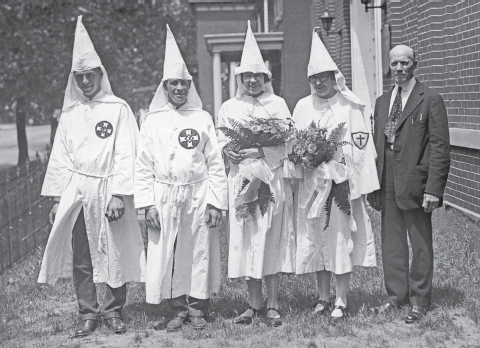Exploring American Histories: Printed Page 670
Documents 21.3 and 21.4
Men and Women of the KKK: Two Views

While the new Ku Klux Klan grew in power and visibility, many Americans also resisted and ridiculed the organization. In the first selection, journalist Gerald Johnson describes the typical KKK member. The second selection, an excerpt from the bylaws of a Maryland chapter of the Women of the Ku Klux Klan, indicates the group’s devotion to the responsibilities of traditional womanhood. Nearly half a million women joined the women’s auxiliaries of the KKK.
Explore
| 21.3 | Gerald W. Johnson | The Ku Kluxer, 1924 |
The Ku Klux Klan was swept beyond the racial boundaries of the Negro and flourishes now in the Middle West because it is a perfect expression of the American idea that the voice of the people is the voice of God. The belief that the average klansman is consciously affected by an appeal to his baser self is altogether erroneous. In the voice of the organizer he hears a clarion call to knightly and selfless service. It strikes him as in no wise strange that he should be so summoned; is he not, as an American citizen, of the nobility? Politics has been democratized. Social usage has been democratized. Religion has been most astoundingly democratized. Why, then, not democratize chivalry?
The klansman has already been made, in his own estimation, politically a monarch, socially a peer of the realm, spiritually a high priest. Now the Ku Klux Klan calls him to step up and for the trifling consideration of ten dollars he is made a Roland, a Lancelot, a knight-errant vowed to the succor of the oppressed, the destruction of ogres and magicians, the defense of the faith. Bursting with noble ideals and lofty aspirations, he accepts the nomination. The trouble is that this incantation doesn’t work, as none of the others has worked, except in his imagination. King, aristocrat, high priest as he believes himself to be, he is neither royal, noble, nor holy. So, under his white robe and pointed hood he becomes not a Chevalier Bayard [French knight] but a thug.
Source: Gerald W. Johnson, “The Ku Kluxer,” The American Mercury, February 1924, 209–10.
Explore
| 21.4 | Women of the Ku Klux Klan, 1927 |
Objects and Purposes
SECTION 1. The objects of this Order shall be to unite white female persons, native-born Gentile citizens of the United States of America, who owe no allegiance of any nature or degree to any foreign government, nation, institution, sect, ruler, person, or people; whose morals are good; whose reputations and vocations are respectable; whose habits are exemplary; who are of sound minds and 18 years or more of age, under a common oath into a Sisterhood of strict regulation, to cultivate and promote patriotism toward our Civil Government; to practice an honorable clannishness toward each other; to exemplify a practical benevolence; to shield the sanctity of the home and the chastity of womanhood; to maintain forever white supremacy; to teach and faithfully inculcate a high spiritual philosophy through an exalted ritualism, and by a practical devotion to conserve, protect, and maintain the distinctive institutions, rights, privileges, principles, traditions, and ideals of a pure Americanism.
SEC. 2. To create and maintain an institution by which the present and succeeding generations shall commemorate the great sacrifice, chivalric service, and imperishable achievements of the Ku Klux Klan and the Women of the Reconstruction period of American History, to the end that justice and honor be done the sacred memory of those who wrought through our mystic society during that period, and that their valiant accomplishments be not lost to posterity; to perpetuate their faithful courage, noble spirit, peerless principles, and faultless ideals; to hold sacred and make effective their spiritual purpose in this and future generations, that they be rightly vindicated before the world by a revelation of the whole truth.
Source: Women of the KKK (Maryland) Records, Schlesinger Library, Radcliffe Institute, Harvard University, reprinted in Modern American Women, ed. Susan Ware (Boston: McGraw-Hill, 2002), 136–37.
Interpret the Evidence
Question
How does Johnson describe the typical KKK member?
Question
How do each of these statements identify the central purpose of the KKK?
Put It in Context
Question
Why did the KKK and other nativist groups appeal to so many people during the 1920s?